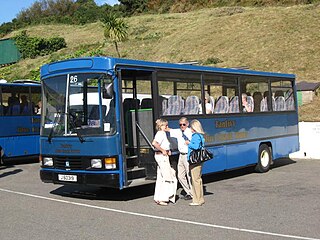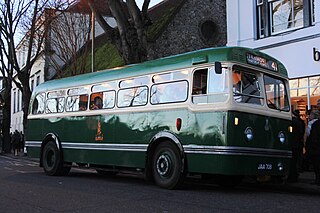| Albion Aberdonian | |
|---|---|
| Overview | |
| Manufacturer | Albion |
| Production | 1957-60 |
| Body and chassis | |
| Doors | 1-2 |
| Floor type | Step entrance |
| Powertrain | |
| Engine | Leyland O350H diesel engine Leyland O375H diesel engine |
| Power output | 97-107bhp |
| Transmission | Albion 5 or 6 speed constant-mesh |
| Dimensions | |
| Length | 30 ft (9.1 m) |
The Albion Aberdonian was an underfloor-engined bus designed and manufactured by Albion Motors between 1957 and 1960, it was introduced as a longer derivative of the Albion Nimbus.

Albion Motors was a Scottish automobile and commercial vehicle manufacturer.

The Albion Nimbus was an underfloor-engined, ultra-lightweight midibus or coach chassis, with a four-cylinder horizontal diesel engine and a gross vehicle weight of six tons. It was largely operated on light rural bus duties and private hires. Operators who used it on heavy-duty bus routes found it insufficiently robust. It was the first Albion bus chassis to have a name that did not begin with the letter V. The design was revised twice and was produced from 1955 to 1965.
Contents
The Aberdonian, development code "Nimbus-Six", was designed to be the lightest full-size underfloor-engined bus available. Bodied examples would weigh half a ton less than the similarly powered Leyland Tiger Cub. Launch was at the 1957 Scottish Motor Show at the Kelvin Hall where an Alexander bodied coach demonstrator in Edinburgh Corporation livery weighing less than five tons unladen was shown. It was the fourth Albion bus designed with an underfloor engine, the third type manufactured, the second after the Leyland takeover and the second named Albion bus chassis not to have a name beginning with V. [1]

The Leyland Tiger Cub was a lightweight underfloor-engined chassis manufactured by Leyland between 1952 and 1970.

The Kelvin Hall in Argyle Street Glasgow, Scotland, is one of the largest exhibition centres in Britain and now a mixed-use arts and sports venue that opened as an exhibition venue in 1927. It has also been used as a concert hall, home to the Kelvin Hall International Sports Arena to 2014, and from 1987 to 2010, Glasgow's Museum of Transport. As part of the economic redevelopment of Greater Glasgow promoted by the Scottish Development Agency and local authorities to enhance the city's tourist infrastructure and to attract further national and international conferences the Scottish Exhibition and Conference Centre was designed as the Hall's successor for exhibitions and entertainments, built and opened on the nearby Queen's Dock in 1985 with an exhibition area equal in size to the Kelvin Hall but with the benefit of extensive car parks and land for other complementary buildings. The Hall is protected as a category B listed building, and is served by city bus services and by Kelvinhall subway station.
Walter Alexander Coachbuilders was a Scottish builder of bus and coach bodywork based in Falkirk. The company was formed in 1947 to continue the coachbuilding activities of W. Alexander & Sons when their bus service operation was nationalised. After several mergers and changes of ownership it now forms part of Alexander Dennis.
An Aberdonian is a native of Aberdeen and within Scotland Aberdonians are traditionally considered miserly. As the current editor of Buses put it this was a bus designed to sip rather than gulp fuel.

Aberdeen is a city in northeast Scotland. It is Scotland's third most populous city, one of Scotland's 32 local government council areas and the United Kingdom's 37th most populous built-up area, with an official population estimate of 196,670 for the city of Aberdeen and 228,800 for the local council area.
















